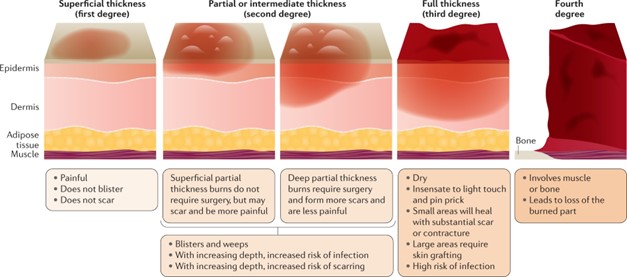When caring for a client with full-thickness burns to both lower extremities, which assessment finding(s) warrant immediate intervention by the nurse? (Select all that apply.)
Sloughing tissue around wound edges.
Change in the quality of the peripheral pulses.
Weeping serosanguineous fluid from wounds.
Loss of sensation to the left lower extremity.
Complaint of increased pain and pressure.
Correct Answer : B,D,E
These findings suggest potential complications and compromise to the client's circulation and nerve function, which require immediate attention.
Changes in the quality of peripheral pulses indicate alterations in blood flow and may suggest vascular compromise or decreased perfusion to the affected areas. This finding requires immediate intervention to prevent further damage and ensure adequate blood supply to the extremities.
Loss of sensation to the left lower extremity can be indicative of nerve injury or impaired peripheral nerve function. It is important to assess for nerve damage and address it promptly to prevent complications and maximize the client's recovery.
Complaints of increased pain and pressure are concerning because they may indicate the development of compartment syndrome, a serious complication in which pressure within the muscles and tissues builds up to dangerous levels. Prompt intervention is necessary to relieve the pressure and prevent tissue damage.
While sloughing tissue around wound edges and weeping serosanguineous fluid from wounds are important assessment findings in the context of burn care, they do not require immediate intervention compared to the findings mentioned above. These findings should still be addressed and managed appropriately, but they are not considered immediate emergencies.

Nursing Test Bank
Naxlex Comprehensive Predictor Exams
Related Questions
Correct Answer is D
Explanation
The client's statement of feeling worthless most days and having no interest in activities she previously enjoyed indicates a potential risk for self-directed violence, including self-harm or suicidal ideation. These signs are significant and require immediate attention and intervention by the nurse.
Assessing and addressing the client's risk for self-directed violence is of utmost importance to ensure her safety and well-being. The nurse should initiate a thorough assessment of the client's mental health, including assessing for any suicidal ideation, intent, or plans. It is crucial to establish a supportive and non-judgmental environment for the client to express her feelings and concerns.
The nurse should collaborate with the healthcare team to develop an appropriate care plan that may involve interventions such as close observation, involving a mental health professional, implementing safety measures, and providing emotional support.
While addressing other nursing problems, such as anxiety, imbalanced nutrition, and chronic low self-esteem, is important, the immediate concern is the client's risk for self-directed violence due to her feelings of hopelessness.
Correct Answer is A,B,C,D,E
Explanation
A) This is because the client is experiencing an allergic reaction to piperacillin, which can be life-threatening. The nurse should stop the infusion immediately to prevent further exposure to
the drug and assess vital signs to monitor for signs of anaphylaxis, such as hypotension, tachycardia, wheezes, or stridor.
B) Assessing vital signs is a priority to determine the severity of the reaction and the client's overall condition.
C) The nurse should contact the healthcare provider to report the situation and obtain orders for treatment, such as antihistamines, corticosteroids, or epinephrine.
D) The nurse should initiate an adverse event report to document the incident and follow the facility's protocol for reporting medication errors.
E) The nurse should also document the reaction to the drug in the client's chart and notify the pharmacy to avoid future administration of piperacillin or related antibiotics.

Whether you are a student looking to ace your exams or a practicing nurse seeking to enhance your expertise , our nursing education contents will empower you with the confidence and competence to make a difference in the lives of patients and become a respected leader in the healthcare field.
Visit Naxlex, invest in your future and unlock endless possibilities with our unparalleled nursing education contents today
Report Wrong Answer on the Current Question
Do you disagree with the answer? If yes, what is your expected answer? Explain.
Kindly be descriptive with the issue you are facing.
